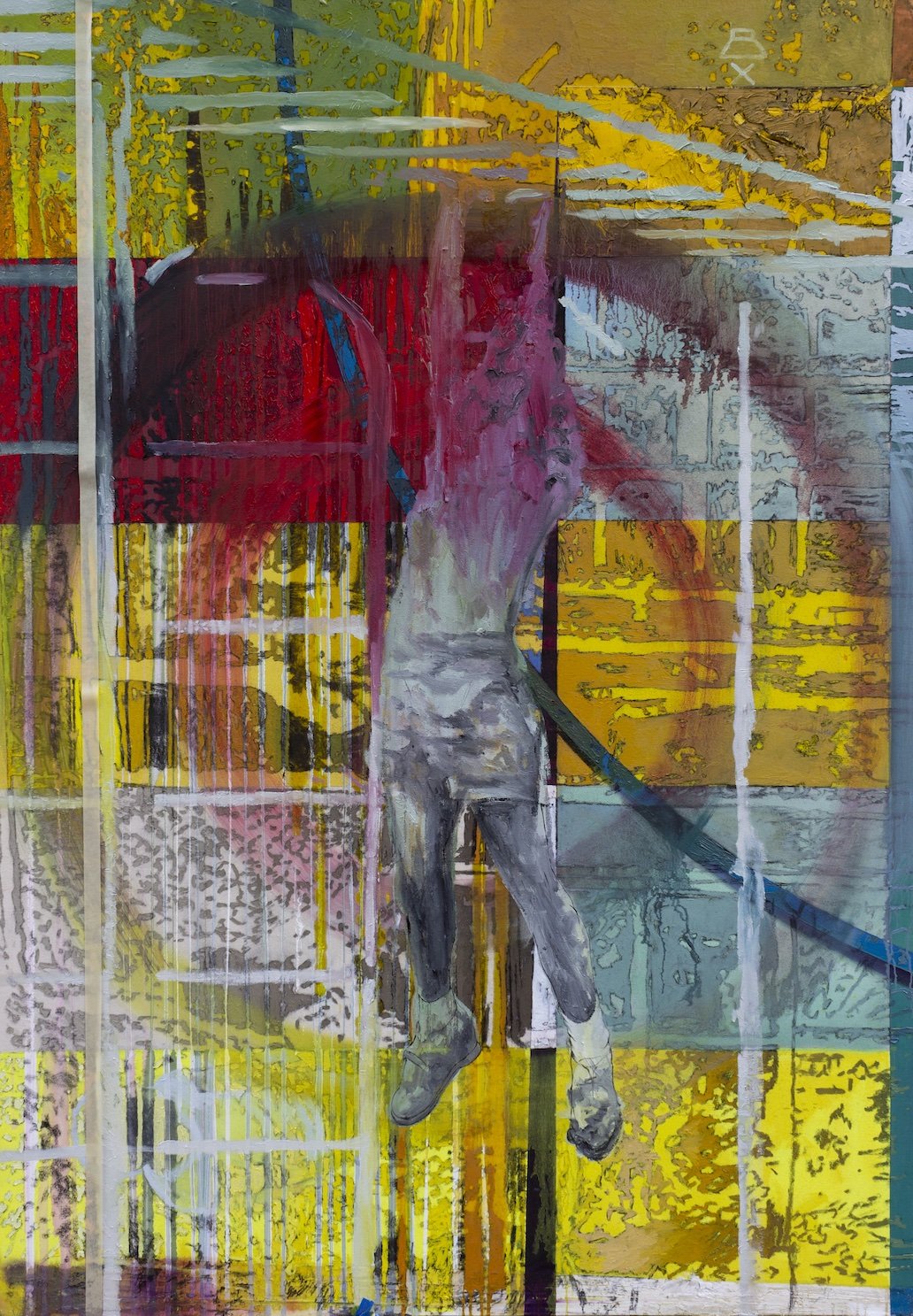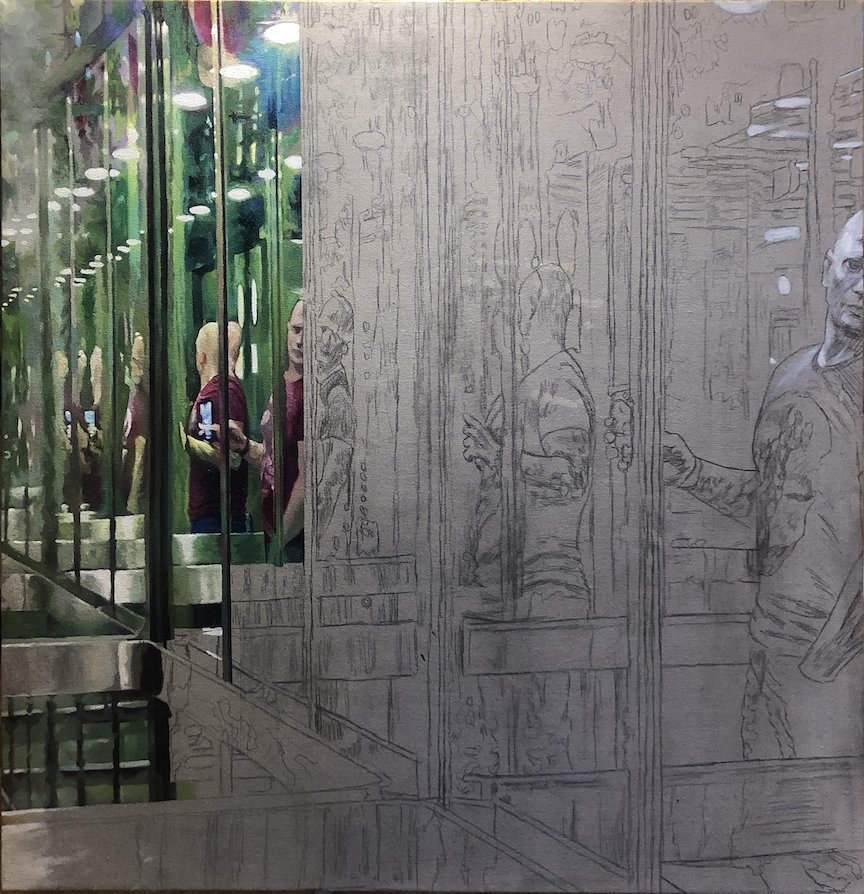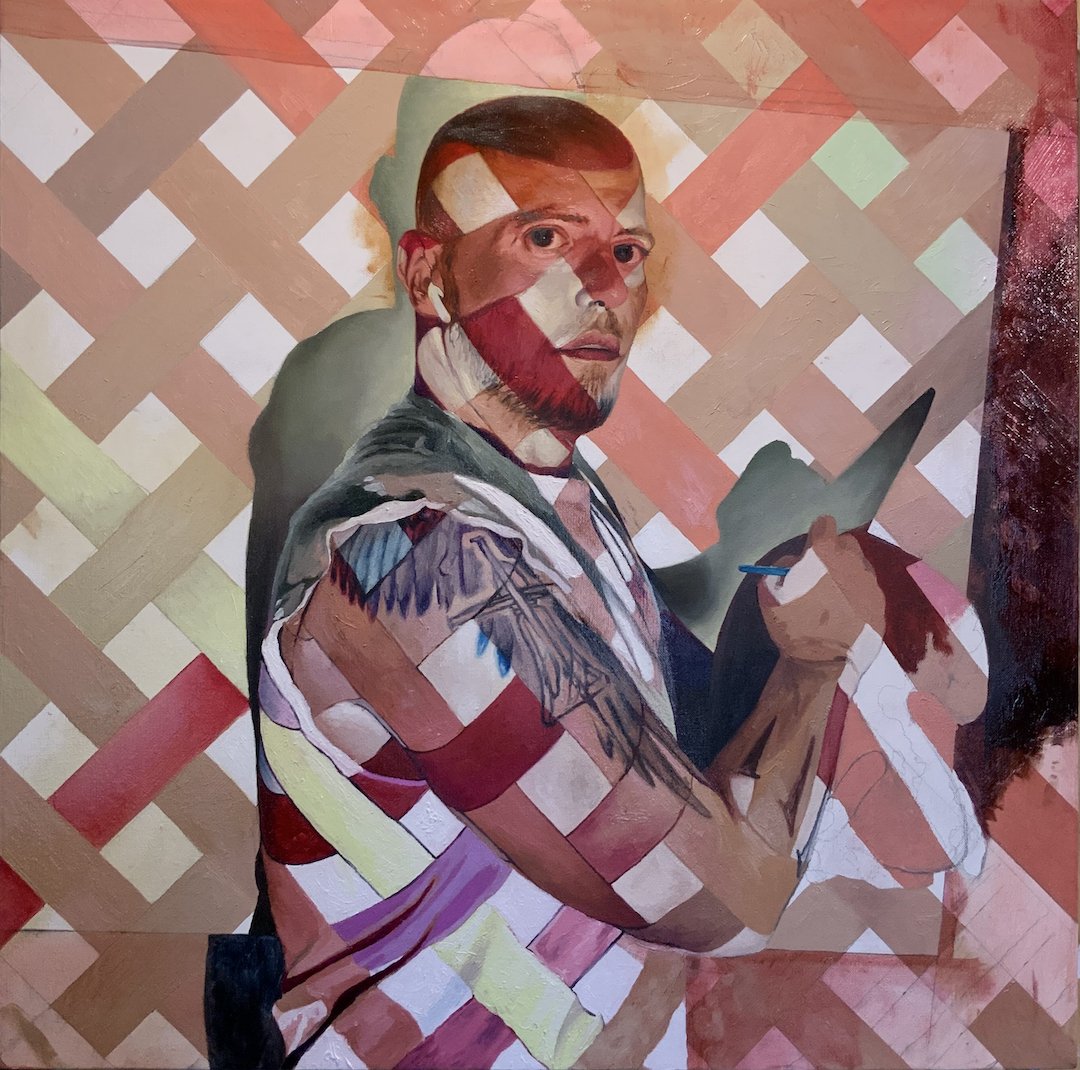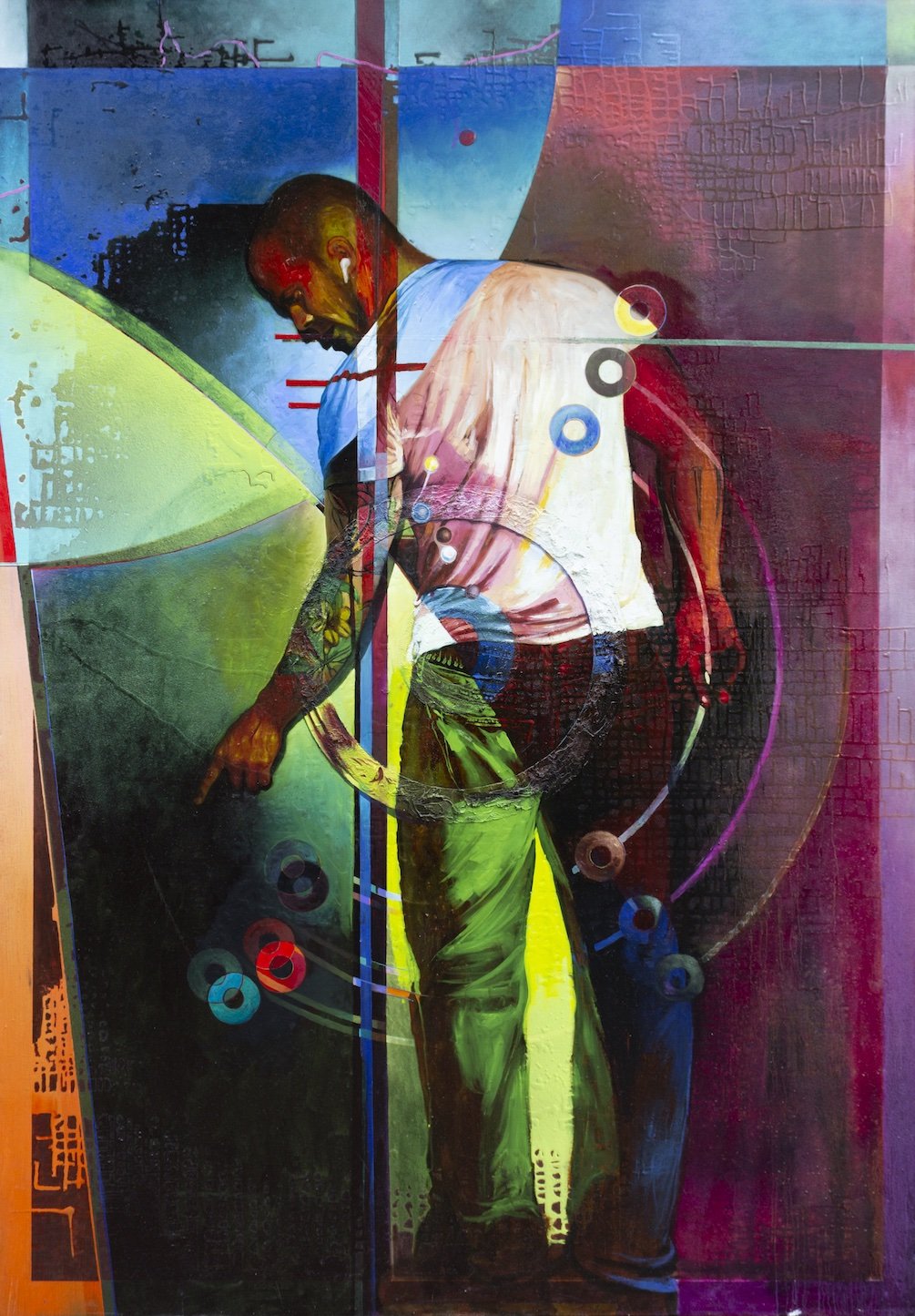Interview with artist Jody Travis Thompson
Jody Travis Thompson grew up in Southwest Louisiana. Following a BA in art from McNeese State University in Lake Charles, Louisiana, he attended the University of Arkansas, Fayetteville, where he earned an MFA. He also spent time at the New York Studio School. Jody has settled in Fayetteville and is Foundations Coordinator and Instructor of Studio Art in the University of Arkansas Fulbright College of Arts and Sciences School of Art. Jody is always challenging himself artistically and his skill is remarkable. More of Jody’s work can be found at his website jodytravisthompson.com.



AAS: Jody, we have something in common. We both grew up in south Louisiana. What eventually brought you to Arkansas?
JTT: The road to Arkansas took me from Sulphur, Louisiana, up to the east coast; Baltimore, D.C., New York City, Asbury Park, New Jersey, and then to Fayetteville. I started taking painting lessons when I was eleven years old and continued until I was 18. I enrolled at McNeese State University in Lake Charles, Louisiana after High School. About three years into an Accounting Degree, I took a painting class to fulfill a credit requirement. That evening I went home and told Mama and Daddy that I was switching my major. A couple of years after graduating, I had been working at a riverboat casino in Lake Charles and an artist friend of mine from McNeese had moved to Baltimore, Maryland, and invited me to move up there. I and two friends moved in 1998. After spending a couple of years in Baltimore, and then Washington D.C, I moved to New York City in August of 2001 to be with my boyfriend at the time. While in New York, I continued to paint and keep an active studio practice. I eventually moved to Asbury Park, New Jersey, where I got sober and clean from drugs and alcohol in 2009. In 2015, I realized that I wanted a new experience with my painting but could not figure out how to do that for myself. One of my professors from McNeese suggested that I think about going back to school and getting my master’s degree. Among other universities, I applied at the University of Arkansas. The University of Arkansas offered the most grants and stipends, so this is where I accepted. I can say, Crystal Bridges and the art scene here were big pluses, but following the money is oftentimes a necessary evil when making professional decisions as an artist.
“…we limit ourselves when we think inspiration must come from some lofty, higher ideas. Inspiration is always around us.”
AAS: I know the Sulphur area pretty well. Don’t remember there being much art around there for inspiration. What inspired you to become an artist?
JTT: This question makes me smile every time I am asked. My family have always been “creative” mostly when it comes to music. However, in 1980, I watched the movie Xanadu starring Olivia Newton-John and Gene Kelley. It was the most magical thing that I had ever seen. The main character’s name was Sonny, the artist, and he met and fell in love with Kira, one of the nine muses of inspiration from Greek mythology. Xanadu is one of the best/worst movies ever made; it is roller disco of the 70’s meets the Big Band era of the 40’s. But I used to pretend that I was both Sonny AND Kira. I would make drawings of all of my favorite scenes in the movie as if I was Sonny, and then put on my roller skates and go outside and pretend that I had magic powers. I will say that I watched it so many times, especially after I saved my allowance to buy my own VHS copy, that my brother and sister still cringe to this day when they hear its music.
A little after I saw that movie, I started watching Bob Ross’ The Joy of Painting on Saturday mornings. I convinced Mama to buy me an oil painting set, and I started duplicating his paintings in my room after the episode would end. Eventually, Mama wanted to replace the carpet in my bedroom that I had ruined with oil paint. I am still pretty messy in the studio. She said that I couldn’t paint in there anymore but would enroll me in a weekly painting class with my Aunt Marlene. Mrs. Jane Ludwig-Johnson was a local artist that taught the class. She would put up one of her paintings and we would duplicate it. These were mainly bayou scenes or Southwest Louisiana nature scenes. Mama still has many of these paintings at her house.
AAS: Did your painting lessons as a kid inspire you to become an art educator?
JTT: I only told my Daddy that I was going to teach because he asked me how I was going to make a living as an artist. Even in undergrad, I did not honestly see myself teaching. When I was younger, I didn’t understand why everyone couldn’t just look at something and paint or draw it. It wasn’t until I was in grad school that I was able to see that teaching technique is only part of being an Art Educator. Honestly, it was working as a TA in Foundations at the U of A that inspired me to want to teach full time. The first time I saw the sense of accomplishment that a student had when they put up their first drawing in the class, next to their final drawing after they had learned all of the techniques, sealed the deal for me.
AAS: Jody, before we talk about some of your more recent work, I want to ask you about your earlier figurative and portrait work. Two pieces that are so powerful and moving are Sean and Matthew and Hap. Is there a story behind those?
Sean and Matthew, 10” x 8”, oil on canvas
JTT: Thank you! During the years when I lived in New York City and New Jersey, my studio was a closet (literally), then a space in the bathroom, then a corner of my bedroom, etc. Space in that region is premium, so you paint where you can. Mainly because of limited painting space, I focused on painting smaller portraits of the people around me. Sean was of my boyfriend at the time and Matthew was my best friend. These were the two people at the time who I trusted and admired the most.
Hap, 14” x 11”, oil on canvas
The landing outside of our apartment on the top floor of a 4th floor walkup, had this skylight that cast a very Caravaggio-esque light that just begged to be in a painting. Hap was the father of my ex-husband in New Jersey. In real life, Hap was a boisterous personality whose part time job was playing Santa Claus during the holidays. He always reminded me of one of those old men in a Caravaggio or da Vinci painting.
AAS: Another wonderful piece with strong light and an Old-World Renaissance feel is Becoming Aware. Her face is extraordinary and of course, the pose and setting – the whole image is just great and beautifully executed.
Becoming Aware, 60” x 40”, oil on canvas
JTT: Ah yes, that painting. Becoming Aware was done when I lived near the beach in Asbury Park. One of my best friends and, at the time, roommate, Tara agreed to model for this painting. This painting was done when I was about 5 years sober. I am by no means religious, but I am spiritual. I do believe that something bigger than me keeps me clean and sober. This painting happened at a time when I realized that I was beginning to run on self-will (again). I always picture the power greater than me as being the ocean and I spent much of my time there gaining peace and serenity. I also wanted to try my hand at trying to paint the difference in how water moves when being poured from a glass vessel, compared with how water moves when it is in the ocean.
AAS: Your MFA Thesis Exhibition in 2019 was titled Liable to Change and there you displayed some of what you call ‘material driven abstraction’. Would you talk about that body of work and two pieces in particular, From The Other Side and Phenomenon?
JTT: The way that I was trained to paint was to have control over oil paint; to make it do what I wanted it to do and pretend to be what/who it was that I was painting. Wanting a new experience with painting meant that I had to set aside, temporarily, what I thought I knew about what painting is. Right out of the gate, in the grade program at the U of A, I tried not to use any of the methods that I had always used when making a painting. I found that, by using materials that I would not have considered to be high art materials, (wax, duct tape, resin, makeup, spray paint, etc.) the materials performed in ways that I could not predict, and many times, control. I quickly learned that, in my previous contempt for anything non-oil paint, I had been continuing to enforce a biased, Eurocentric idea of what painting had to be to be “good”.
From The Other Side, 70” x 70”, oil, acrylic, makeup, resin, graphite and enamel on canvas
For my thesis exhibition, I wanted to build a body of work that had its conceptual drive begun in ideas and thought experiments that questioned the nature of perception, memory, and reality. I studied the Golden Ratio, Flower of Life pattern, prisms, etc. I also started buying eyeshadow pallets and using those pigments, I made my own paint using linseed oil. In these paintings, I combined my handmade paint with oil paint, acrylic, enamel, resin, duct tape, beeswax, etc. In From The Other Side, I had a three sided prism rod that could be free standing. I painted the painting and then positioned the prism in front of it to see how it altered what I saw when I looked through it back at the painting. I loved the way that I could render my altered view of a painting back onto the original painting. I also began experimenting with bringing back trompe l’oeil realism to fool the viewer’s eye in painting what looks like real light and shadow being cast on the painting from above.
Phenomenon is a painting that has its beginnings from the Golden Ratio. At this point, I was enjoying the act of beginning with a predetermined structure and then seeing how action, gravity, and the material’s properties would guide the development of the picture. Toward the end of the making of the painting, I wanted to see how trompe l’oeil realism could be brought in to expand the interior space of the painting and make the viewer question whether what they are looking at is painted or physically positioned in space in front of the painting. Also, the paintings in this show are also great examples of how my three years of painting differently gave me the freedom to explore how color and hue can activate pictural, emotional, and physical space in the composition of a painting.
Phenomenon, 70” x 108”, oil, acrylic, makeup, resin, graphite and enamel on canvas
AAS: I guess maybe my favorite work from that exhibition, which I only got to see online, is Uroboros. It is spectacular!
Uroboros, 70” x 70”, oil, acrylic, makeup, resin, graphite and enamel on canvas
JTT: This makes me smile as well. As a side note, this is one of the paintings that is on extended exhibition in the Miller Lodge up at Mount Sequoyah Center where my studio currently is. Anyway, the Uroboros is an ancient Egyptian and Greek magical alchemical symbol representing eternity and endless return. This painting is the third in a tryptic. For this painting, I had been thinking about how I could represent this without using the traditional circle of a snake eating its own tail. I had just gotten home from the gym and was rinsing out my protein shake bottle. I looked down into the open container and saw the rather large, metal, mixing ball. I knew in that moment that this was what the Uroboros would look like in three dimensions. I always make a point to say this when someone asks. Just like not being ashamed of initially learning to paint by watching Bob Ross, or being inspired to paint by watching Xanadu, we limit ourselves when we think inspiration must come from some lofty, higher ideas. Inspiration is always around us. Sometimes a protein shake mixer ball can represent the never-ending cycle of creation from destruction.
AAS: Some of your most recent work really shows off your rendering skills. Would you talk about Perceived State and Father?
Perceived State, 30” x 20”, oil on panel
JTT: After spending three years focused on materials and color, I felt the need to let the movement and action happen in the observed object. This is one of my favorite things about looking at some black and white imagery. While my apartment is ALWAYS neat, clean and organized (my brain needs this to retreat into after the unpredictability of everyday life), my studio is a space where I try to barely keep a reign on chaos. Throughout my life, I find funny, and sometimes a little scary, objects that bring me joy by having them in my creative space. Many of these objects are toys that I have kept from my childhood. My extensive collection of GoBots is one example.
The works you mentioned are from a series of four, black and white, photo-realistic, still-life oil paintings that I did in the studio. Perceived State is an homage to the use of prisms and makeup in my thesis work. I also wanted to be able to see how these shapes would function if color was removed from their purpose in the picture. Also, the robot figure is one of my favorite GoBots. I do always love how these little toys are BOTH a vehicle and a figure regardless of what form they are presenting. Also, I wanted to pay homage to the environment up at Mount Sequoyah by bringing some of the outside, inside.
Father, 30” x 20”, oil on panel
Father is definitely what it feels like sometimes when I remember my Daddy. He passed away around 18 years ago. I find that the more time passes, some of my memories become more clear, while others feel like someone is slowly dimming a light. This painting is of a few objects that he gave to me or that I took after he moved on. The small plastic molded hand where he made lawyers put their gum when they came to his office to talk (Daddy was a Judge); a bottle of dirt from his grave the day he was buried; and so on. There is another GoBot hidden in this painting as well: when someone dies, they are both with us and not with us. When memory starts to fade, it helps to be able to hold something tangible.
AAS: You are a past recipient of a fellowship from the Arkansas Arts Council and have a residency at the Mount Sequoyah Center in Fayetteville, where your studio is located. While I’m sure it could always be better, what is the support like for young artists in Arkansas, especially in Northwest Arkansas?
JTT: The amount of monetary, physical, emotional and physical support that I have received from the University and local art communities is truly a blessing. As you mentioned, the Arkansas Arts Council grant that I was awarded allowed me to be able to purchase ALL of the supplies that I needed to make work for a year in my AMAZING studio space in the Sequoyah Center up at Mount Sequoyah. After receiving my MFA, I started looking for studio space in Fayetteville. Every place that I looked at (this is way back in 2019) was out of my price range. When I went up to Mount Sequoyah, they offered the space that I am currently in. It was not only beautiful but was right in my price range. Over time, they have continued to open up affordable studio space on all of the floors in Sequoyah Hall as well as across the campus. What has grown, in no small part due to Jessica DeBari, is an environment and community that fosters interaction and space for artists of all kinds. Another great example of this has been the invitation by Zeek Taylor to be a part of a group exhibition at the First National Bank in Bentonville.
This region does support young artists through outreach and programs like summer programs at Mount Sequoyah and the U of A and the Summer Art Camp for Queer Kids at Good Shepherd Lutheran Church. There are opportunities for young artists in Arkansas, but more outreach, specifically to BIPOC, LGBTQ+, and other marginalized communities needs to happen.
AAS: Teaching Studio Art and Foundations courses certainly eats up your time to paint. But, what is next for you? Where do you hope to take your career and art in the next five years?
JTT: Well, within the next 5 years, my range of solo and group exhibitions will be continuing. I can’t express my gratitude enough to the School of Art at the University of Arkansas for all of the love, support, and professional experience they have given me during and after receiving my MFA. I am currently working on a series of self-portraits, which explore my self-reflection and questioning of my own identity, whiteness and mining my own personal biases and perceptions of what is “real”.







